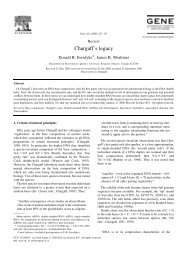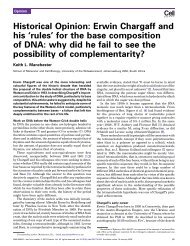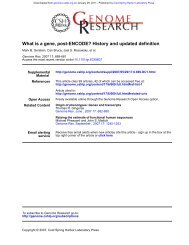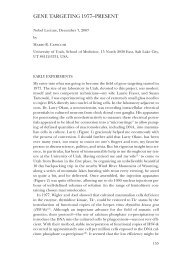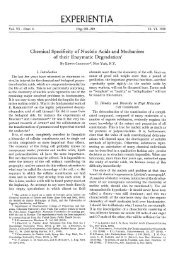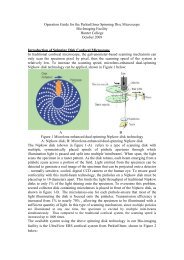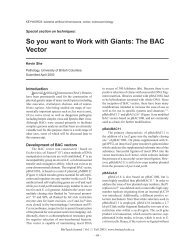Cold Spring Harb Symp Quant Biol-1953-Watson-SQB ... - Biology
Cold Spring Harb Symp Quant Biol-1953-Watson-SQB ... - Biology
Cold Spring Harb Symp Quant Biol-1953-Watson-SQB ... - Biology
Create successful ePaper yourself
Turn your PDF publications into a flip-book with our unique Google optimized e-Paper software.
Downloaded from symposium.cshlp.org on March 26, 2009 - Published by <strong>Cold</strong> <strong>Spring</strong> <strong>Harb</strong>or Laboratory Press<br />
THE STRUCTURE OF DNA<br />
J. D. <strong>Watson</strong> and F. H. C. Crick<br />
<strong>Cold</strong> <strong>Spring</strong> <strong>Harb</strong> <strong>Symp</strong> <strong>Quant</strong> <strong>Biol</strong> <strong>1953</strong> 18: 123-131<br />
Access the most recent version at doi:10.1101/<strong>SQB</strong>.<strong>1953</strong>.018.01.020<br />
References<br />
Email alerting<br />
service<br />
This article cites 21 articles, 3 of which can be accessed free at:<br />
http://symposium.cshlp.org/content/18/123.refs.html<br />
Article cited in:<br />
http://symposium.cshlp.org/content/18/123#related-urls<br />
Receive free email alerts when new articles cite this article - sign up in<br />
the box at the top right corner of the article or click here<br />
To subscribe to <strong>Cold</strong> <strong>Spring</strong> <strong>Harb</strong>or <strong>Symp</strong>osia on <strong>Quant</strong>itative <strong>Biol</strong>ogy go to:<br />
http://symposium.cshlp.org/subscriptions<br />
Copyright © <strong>1953</strong> <strong>Cold</strong> <strong>Spring</strong> <strong>Harb</strong>or Laboratory Press
Downloaded from symposium.cshlp.org on March 26, 2009 - Published by <strong>Cold</strong> <strong>Spring</strong> <strong>Harb</strong>or Laboratory Press<br />
THE STRUCTURE OF DNA<br />
J. D. WATSON i AND F. H. C. CRICK<br />
Cavendish Laboratory, Cambridge, England<br />
(Contribution to the Discussion of Provirus.)<br />
It would be superfluous at a <strong>Symp</strong>osium on Viruses<br />
to introduce a paper on the structure of DNA<br />
with a discussion on its importance to the problem<br />
of virus reproduction. Instead we shall not only<br />
assume that DNA is important, but in addition that<br />
it is the carrier of the genetic specificity of the<br />
virus (for argument, see Hershey, this volume) and<br />
thus must possess in some sense the capacity for<br />
exact self-duplication. In this paper we shall describe<br />
a structure for DNA which suggests a mechanism<br />
for its self-duplication and allows us to propose,<br />
for the first time, a detailed hypothesis on<br />
the atomic level for the self-reproduction of genetic<br />
material.<br />
We first discuss the chemical and physical-chemical<br />
data which show that DNA is a long fibrous<br />
molecule. Next we explain why crystallographic<br />
evidence suggests that the structural unit of DNA<br />
consists not of one but of two polynucleotide chains.<br />
We then discuss a stereochemical model which we<br />
believe satisfactorily accounts for both the chemical<br />
and crystallographic data. In conclusion we suggest<br />
some obvious genetical implications of the<br />
proposed structure. A preliminary account of some<br />
of these data has already appeared in Nature (<strong>Watson</strong><br />
and Crick, <strong>1953</strong>a, <strong>1953</strong>b).<br />
I. EVIDENCE FOR THE FIBROUS NATURE OF DNA<br />
The basic chemical formula of DNA is now well<br />
established. As shown in Figure 1 it consists of a<br />
very long chain, the backbone of which is made up<br />
of alternate sugar and phosphate groups, joined together<br />
in regular 3' 5' phosphate di-ester linkages.<br />
To each sugar is attached a nitrogenous base, only<br />
four different kinds of which are commonly found<br />
in DNA. Two of these---adenine and guanine---<br />
are purines, and the other two thymine and cytosine-are<br />
pyrimidines. A fifth base, 5-methyl<br />
cytosine, occurs in smaller amounts in certain organisms,<br />
and a sixth, 5-hydroxy-methyl-cytosine, is<br />
found instead of cytosine in the T even phages<br />
(Wyatt and Cohen, 1952).<br />
It should be noted that the chain is unbranched,<br />
a consequence of the regular internucleotide ]inkage.<br />
On the other hand the sequence of the different<br />
nucleotides is, as far as can he ascertained,<br />
completely irregular. Thus, DNA has some features<br />
which are regular, and some which are irregular.<br />
A similar conception of the DNA molecule as a<br />
1 Aided by a Fellowship from the National Foundation<br />
for Infantile Paralysis.<br />
[123]<br />
long thin fiber is obtained from physico-chemieal<br />
analysis involving sedimentation, diffusion, light<br />
scattering, and viscosity measurements. These techniques<br />
indicate that DNA is a very asymmetrical<br />
structure approximately 20 A wide and many thousands<br />
of angstroms long. Estimates of its molecular<br />
weight currently center between 5 X 10 ~ and<br />
107 (approximately 3 )< 104 nucleotides). Surprisingly<br />
each of these measurements tend to suggest<br />
that the DNA is relatively rigid, a puzzling<br />
finding in view of the large number of single bonds<br />
(5 per nucleotide) in the phosphate-sugar back-<br />
BASE<br />
D.N.A.<br />
SUGAR<br />
\<br />
/<br />
BASE-- SUGAR<br />
BASE<br />
BASE<br />
BASE<br />
SUGAR<br />
\<br />
/<br />
\<br />
/<br />
- SUGAR<br />
\<br />
/<br />
\<br />
SUGAR<br />
PHOSPHATE<br />
PHOSPHATE<br />
PHOSPHATE<br />
PHOSPHATE<br />
PHOSPHATE<br />
Fmurm 1. Chemical formula (diagrammatic) of a single<br />
chain of desoxyribonucleic acid.
Downloaded from symposium.cshlp.org on March 26, 2009 - Published by <strong>Cold</strong> <strong>Spring</strong> <strong>Harb</strong>or Laboratory Press<br />
124 ]. D. WATSON AND F. H. C. CRICK<br />
bone. Recently these indirect inferences have been<br />
confirmed by electron microscopy. Employing high<br />
resolution techniques both Williams (1952) and<br />
Kahler et al. (<strong>1953</strong>) have observed, in preparations<br />
of DNA, very long thin fibers with a uniform width<br />
of approximately 15-20 A.<br />
II. EVIDENCE FOR THE EXISTENCE OF TWO C~E~I-<br />
CAL CHAINS IN THE FIBER<br />
This evidence comes mainly from X-ray studies.<br />
The material used is the sodium salt of DNA (usually<br />
from calf thymus) which has been extracted,<br />
purified, and drawn into fibers. These fibers are<br />
highly birefringent, show marked ultraviolet and<br />
infrared dichroism (Wilkins et al., 1951; Fraser<br />
and Fraser, 1951), and give good X-ray fiber diagrams.<br />
From a preliminary study of these, Wilkins,<br />
Franklin and their co-workers at King's College,<br />
London (Wilkins et al., <strong>1953</strong>; Franklin and<br />
Gosling <strong>1953</strong>a, b and c) have been able to draw<br />
certain general conclusions about the structure of<br />
DNA. Two important facts emerge from their<br />
work. They are:<br />
(1) Two distinct ]orms of DNA exist. Firstly a<br />
crystalline form, Structure A, (Figure 2) which<br />
occurs at about 75 per cent relative humidity and<br />
contains approximately 30 per cent water. At higher<br />
humidities the fibers take up more water, increase<br />
in length by about 30 per cent and assume<br />
Structure B (Figure 3). This is a less ordered<br />
form than Structure A, and appears to be paracrystalline;<br />
that is, the individual molecules are all<br />
packed parallel to one another, but are not otherwise<br />
regularly arranged in space. In Table 1, we<br />
have tabulated some of the characteristic features<br />
which distinguish the two forms. The transition<br />
from A to B is reversible and therefore the two<br />
.structures are likely to be related in a simple<br />
manner.<br />
(2) The crystallographic unit contains two polynucleotide<br />
chains. The argument is crystallographic<br />
and so will only be given in outline. Structure B<br />
has a very strong 3.4 A reflexion on the meridian.<br />
As first pointed out by Astbury (1947), this can<br />
only mean that the nucleotides in it occur in groups<br />
spaced 3.4 A apart in the fiber direction. On going<br />
from Structure B to Structure A the fiber shortens<br />
by about 30 per cent. Thus in Structure A the<br />
~roups must he about 2.5 per cent A apart axially.<br />
The measured density of Structure A, (Franklin<br />
FIGURE 2. X-ray fiber diagram of Structure A of desoxyribonucleic<br />
acid. (H. M. F. Wilkins and H. R. Wilson,<br />
unpub.)<br />
and Gosling, <strong>1953</strong>c) together with the cell dimensions,<br />
shows that there must be two nucleotides in<br />
each such group. Thus it is very probable that the<br />
crystallographic unit consists of two distinct polynucleotide<br />
chains. Final proof of this can only<br />
come from a complete solution of the structure.<br />
Structure A has a pseudo-hexagonal lattice, in<br />
which the lattice points are 22 A apart. This distance<br />
roughly corresponds With the diameter of<br />
fibers seen in the electron microscope, bearing in<br />
mind that the latter are quite dry. Thus it is probable<br />
that the crystallographic unit and the fiber<br />
are the one and the same.<br />
III. DESCRIPTION OF THE PROPOSED STRUCTURE<br />
Two conclusions might profitably he drawn from<br />
the above data. Firstly, the structure of DNA is<br />
TABLE 1.<br />
(From Franklin and Gosling, <strong>1953</strong>a, b and e)<br />
Number of<br />
Location of<br />
nucleotides<br />
Degree of Repeat distance first equatorial Water within unit<br />
orientation along fiber axis spacing content cell<br />
Structure A Crystalline 28 A 18 A 30% 22-24<br />
Structure B Paraerystalline 34 A 22-24 A > 30% 20 (?)
Downloaded from symposium.cshlp.org on March 26, 2009 - Published by <strong>Cold</strong> <strong>Spring</strong> <strong>Harb</strong>or Laboratory Press<br />
STRUCTURE OF DNA 125<br />
structure is a well-defined one and all bond distances<br />
and angles, including van der Waal distances,<br />
are stereochemicaUy acceptable.<br />
The essential element of the structure is the manner<br />
in which the two chains are held together by<br />
hydrogen bonds between the bases. The bases are<br />
perpendicular to the fiber axis and joined together<br />
in pairs. The pairing arrangement is very specific,<br />
and only certain pairs of bases will fit into the<br />
structure. The basic reason for this is that we have<br />
assumed that the backbone of each polynucleotide<br />
chain is in the form of a regular helix. Thus, irrespective<br />
of which bases are present, the glucosidic<br />
bonds (which join sugar and base) are arranged<br />
in a regular manner in space. In particular,<br />
any two glucosidic bonds (one from each chain)<br />
FiGnag 3. X-ray fiber diagram of Structure B of desoxyribonudeie<br />
acid. (R. E. Franklin and R. Gosling, <strong>1953</strong>a.)<br />
regular enough to form a three dimensional crystal.<br />
This is in spite of the fact that its component<br />
chains may have an irregular sequence of purine<br />
and pyrimidine nucleotides. Secondly, as the structure<br />
contains two chains, these chains must be regularly<br />
arranged in relation to each other.<br />
To account for these findings, we have proposed<br />
(<strong>Watson</strong> and Crick, <strong>1953</strong>a) a structure in which<br />
the two chains are coiled round a common axis<br />
and joined together by hydrogen bonds between<br />
the nucleotide bases (see Figure 4). Both chains<br />
follow right handed helices, but the sequences of<br />
the atoms in the phosphate-sugar backbones run<br />
in opposite directions and so are related by a dyad<br />
perpendicular to the helix axis. The phosphates<br />
and sugar groups are on the outside of the helix<br />
whilst the bases are on the inside. The distance of<br />
a phosphorus atom from the fiber axis is 10 A. We<br />
have built our model to correspond to Structure B,<br />
which the X-ray data show to have a repeat distance<br />
of 34 A in the fiber direction and a very<br />
strong reflexion of spacing 3.4 A on the meridian<br />
of the X-ray pattern. To fit these observations our<br />
structure has a nucleotide on each chain every 3.4<br />
A in the fiber direction, and makes one complete<br />
turn after 10 such intervals, i.e., after 34 A. Our<br />
FIGURE 4. This figure is diagrammatic. The two ribbons<br />
symbolize the two phosphate-sugar chains and the horizontal<br />
rods. The paths of bases holding the chain together.<br />
The vertical line marks the fiber axis.
Downloaded from symposium.cshlp.org on March 26, 2009 - Published by <strong>Cold</strong> <strong>Spring</strong> <strong>Harb</strong>or Laboratory Press<br />
126 /. D. WATSON AND F. H. C. CRICK<br />
which are attached to a bonded pair of bases, must<br />
always occur at a fixed distance apart due to the<br />
regularity of the two backbones to which they are<br />
joined. The result is that one member of a pair of<br />
bases must always be a purine, and the other a<br />
pyrimidine, in order to bridge between the two<br />
chains. If a pair consisted of two purines, for example,<br />
there would not be room for it; if of two<br />
pyrimidines they would be too far apart to form<br />
hydrogen bonds.<br />
In theory a base can exist in a number of tautomeric<br />
forms, differing in the exact positions at<br />
which its hydrogen atoms are attached. However,<br />
under physiological conditions one particular form<br />
of each base is much more probable than any of<br />
the others. If we make the assumption that the<br />
favored forms always occur, then the pairing requirements<br />
are even more restrictive. Adenine can<br />
only pair with thymine, and guanine only with cytosine<br />
(or 5-methyl-cytosine, or 5-hydroxy-methylcytosine).<br />
This pairing is shown in detail in Figures<br />
5 and 6. If adenine tried to pair with cytosine<br />
it could not form hydrogen bonds, since there<br />
would be two hydrogens near one of the bonding<br />
positions, and none at the other, instead of one in<br />
each.<br />
A given pair can be either way round. Adenine,<br />
for example, can occur on either chain, but when<br />
it does its partner on the other chain must always<br />
be thymine. This is possible because the two glucoside<br />
bonds of a pair (see Figures 5 and 6) are<br />
symmetrically related to each other, and thus occur<br />
in the same positions if the pair is turned over.<br />
It should be emphasized that since each base<br />
can form hydrogen bonds at a number of points<br />
one can pair up isolated nucleotides in a large variety<br />
of ways. Specific pairing of bases can only be<br />
obtained by imposing some restriction, and in our<br />
ADENINE o THYMINE<br />
0 5,1<br />
I I i i i i I<br />
FzcuR~. 5. Pairing of adenine and thymine. Hydrogen<br />
bonds are shown dotted. One carbon atom of eaeh sugar<br />
is shown.<br />
GUANINE o CYTOSINE<br />
i , i I I<br />
FIGURE 6. Pairing of guanine and cytosine. Hydrogen<br />
bonds are shown dotted. One carbon atom of each sugar<br />
is shown.<br />
case it is in a direct consequence of the postulated<br />
regularity of the phosphate-sugar backbone.<br />
It should further be emphasized that whatever<br />
pair of bases occurs at one particular point in the<br />
DNA structure, no restriction is imposed on the<br />
neighboring pairs, and any sequence of pairs can<br />
occur. This is because all the bases are flat, and<br />
since they are stacked roughly one above another<br />
like a pile of pennies, it makes no difference which<br />
pair is neighbor to which.<br />
Though any sequence of bases can fit into our<br />
structure, the necessity for specific pairing demands<br />
a definite relationship between the sequences on the<br />
two chains. That is, if we knew the actual order of<br />
the bases on one chain, we could automatically<br />
write down the order on the other. Our structure<br />
there]ore consists o] two chains, each o] which is<br />
the complement o] the other.<br />
IV. EVIDENCE IN FAVOR OF THE COMPLEMENTARY<br />
MODEL<br />
The experimental evidence available to us now<br />
offers strong support to our model though we<br />
should emphasize that, as yet, it has not been<br />
proved correct. The evidence in its favor is of three<br />
types:<br />
(1) The general appearance of the X-ray picture<br />
strongly suggests that the basic structure is<br />
helical (Wilkins et al., <strong>1953</strong>; Franklin and Gosling,<br />
<strong>1953</strong>a). If we postulate that a helix is present, we<br />
immediately are able to deduce from the X-ray pattern<br />
of Structure B (Figure 3), that its pitch is 34<br />
A and its diameter approximately 20 A. Moreover,<br />
the pattern suggests a high concentration of atoms<br />
on the circumference of the helix, in accord with<br />
our model which places the phosphate sugar backbone<br />
on the outside. The photograph also indicates<br />
that the two polynucleotide chains are not<br />
X
Downloaded from symposium.cshlp.org on March 26, 2009 - Published by <strong>Cold</strong> <strong>Spring</strong> <strong>Harb</strong>or Laboratory Press<br />
STRUCTURE OF DNA 127<br />
spaced equally along the fiber axis, but are probably<br />
displaced from each other by about threeeighths<br />
of the fiber axis period, an inference again<br />
in qualitative agreement with our model.<br />
The interpretation of the X-ray pattern of Structure<br />
A (the crystalline form) is less obvious. This<br />
form does not give a meridional reflexion at 3.4 A,<br />
but instead (Figure 2) gives a series of reflexions<br />
around 25 ~ off the meridian at spacings between<br />
3 A and 4 A. This suggests to us that in this form<br />
the bases are no longer perpendicular to the fiber<br />
axis, but are tilted about 25 ~ from the perpendicular<br />
position in a way that allows the fiber to contract<br />
30 per cent and reduces the longitudinal translation<br />
of each nucleotide to about 2.5 A. It should<br />
be noted that the X-ray pattern of Structure A is<br />
much more detailed than that of Structure B and so<br />
if correctly interpreted, can yield more precise information<br />
about DNA. Any proposed model for<br />
DNA must be capable of forming either Structure<br />
A or Structure B and so it remains imperative for<br />
our very tentative interpretation of Structure A to<br />
be confirmed.<br />
(2) The anomolous titration curves of undegraded<br />
DNA with acids and bases strongly suggests that<br />
hydrogen bond formation is a characteristic aspect<br />
of DNA structure. When a solution of DNA is<br />
initially treated with acids or bases, no groups are<br />
titratable at first between pH 5 and pH 11.0, but<br />
outside these limits a rapid ionization occurs (Gulland<br />
and Jordan, 1947; Jordan, 1951). On back<br />
titration, however, either with acid from pH 12 or<br />
with alkali from pH 21,6, a different titration curve<br />
is obtained indicating that the titratable groups are<br />
more accessible to acids and bases than is the untreated<br />
solution. Accompanying the initial release<br />
of groups at pH 11.5 and in the range pH 3.5 to<br />
pH 4.5 is a marked fall in the viscosity and the<br />
disappearance of strong flow birefringence. While<br />
this decrease was originaIly thought to be caused<br />
by a reversible depolymerization (Vilbrandt and<br />
Tennent, 1943), it has been shown by Gulland, Jordan<br />
and Taylor (1947) that this is unlikely as no<br />
increase was observed in the amount of secondary<br />
phosphoryl groups. Instead these authors suggested<br />
that some of the groups of the bases formed hydrogen<br />
bonds between different bases. They were unable<br />
to decide whether the hydrogen bonds linked<br />
bases in the same or in adjacent structural units.<br />
The fact that most of the ionizable groups are originally<br />
inaccessible to acids and bases is more easily<br />
explained if the hydrogen bonds are between bases<br />
within the same structural unit. This point would<br />
definitely be established if it were shown that the<br />
shape of the initial titration curve was the same at<br />
very low DNA concentrations, when the interaction<br />
between neighboring structural units is small.<br />
(3) The analytical data on the relative proportion<br />
of the various bases show that the amount of<br />
adenine is close to that of thymine, and the amount<br />
.of guanine close to the amount of cytosine + 5-<br />
methyl cytosine, although the ratio of adenine to<br />
guanine can vary from one source to another<br />
(Chargaff, 1951; Wyatt, 1952). In fact as the<br />
techniques for estimation of the bases improve, the<br />
ratios of adenine to thymine, and guanine to cytosine<br />
q- 5-methyl cytosine appear to grow very close<br />
to unity., This is a most striking result, especially as<br />
the sequence of bases on a given chain is likely to<br />
be irregular, and suggests a structure involving<br />
paired bases. In fact, we believe the analytical data<br />
offer the most important evidence so far available<br />
in support of our model, since they specifically support<br />
the biologically interesting feature, the presence<br />
of complementary chains.<br />
We thus believe that the present experimental<br />
evidence justifies the working hypothesis that the<br />
essential features of our model are correct and allows<br />
us to consider its genetic possibilities.<br />
V. GENETICAL IMPLICATIONS OF THE<br />
COMPLEMENTARY MODEL<br />
As a preliminary we should state that the DNA<br />
fibers from which the X-ray diffraction patterns<br />
were obtained are not artifacts arising in the method<br />
of preparation. In the first place, Wilkins and<br />
his co-workers (see Wilkins et a/., <strong>1953</strong>) have<br />
shown that X-ray patterns similar to those from<br />
the isolated fibers can be obtained from certain<br />
intact biological materials such as sperm head and<br />
bacteriophage particles. Secondly, our postulated<br />
model is so extremely specific that we find it impossible<br />
to believe that it could be formed during<br />
the isolation from living cells.<br />
A genetic material must in some way fulfil two<br />
functions. It must duplicate itself, and it must<br />
exert a highly specific influence on the cell. Our<br />
model for DNA suggests a simple mechanism for<br />
the first process, but at the moment we cannot see<br />
how it carries out the second one. We believe, however,<br />
that its specificity is expressed by the precise<br />
sequence of the pairs of bases. The backbone of<br />
our model is highly regular, and the sequence is<br />
the only feature which can carry the genetical information.<br />
It should not be thought that because<br />
in our structure the bases are on the "inside," they<br />
would be unable to come into contact with other<br />
molecules. Owing to the open nature of our structure<br />
they are in fact fairly accessible.<br />
A MECHANISM FOR DNA REPLICATION<br />
The complementary nature of our structure, suggests<br />
how it duplicates itself. It is difficult to imagine<br />
how like attracts like, and it has been suggested<br />
(see Pauling and Delbriick, 1940; Friedrich-Freksa,<br />
1940; and Muller, 1947) that self<br />
duolication may involve the union of each part<br />
with an opposite or complementary part. In these<br />
discussions it has generally been suggested that<br />
protein and nucleic acid are complementary to each<br />
other and t~at self replication involves the alternate
Downloaded from symposium.cshlp.org on March 26, 2009 - Published by <strong>Cold</strong> <strong>Spring</strong> <strong>Harb</strong>or Laboratory Press<br />
128 I. D. WATSON AND F. H. C. CRICK<br />
syntheses of these two components. We should like<br />
to propose instead that the specificity of DNA self<br />
replication is accomplished without recourse to specific<br />
protein synthesis and that each of our complementary<br />
DNA chains serves as a template or<br />
mould for the formation onto itself of a new companion<br />
chain.<br />
For this to occur the hydrogen bonds linking<br />
the complementary chains must break and the two<br />
chains unwind and separate. It seems likely that<br />
the single chain (or the relevant part of it) might<br />
itself assume the helical form and serve as a<br />
mould onto which free nucleotides (strictly polynucleotide<br />
precursors) can attach themselves by<br />
forming hydrogen bonds. We propose that polymerization<br />
of the precursors to form a new chain<br />
only occurs if the resulting chain forms the proposed<br />
structure. This is plausible because steric<br />
reasons would not allow monomers "crystallized"<br />
onto the first chain to approach one another in<br />
such a way that they could be joined together in a<br />
new chain, unless they were those monomers which<br />
could fit into our structure. It is not obvious to<br />
us whether a special enzyme would be required to<br />
carry out the polymerization or whether the existing<br />
single helical chain could act effectively as an<br />
enzyme.<br />
DIFFICULTIES IN THE REPLICATION SCHEME<br />
While this scheme appears intriguing, it nevertheless<br />
raises a number of difficulties, none of<br />
which, however, do we regard as insuperable. The<br />
first difficulty is that our structure does not differentiate<br />
between cytosine and 5-methyl cytosine, and<br />
therefore during replication the specificity in sequence<br />
involving these bases would not be perpetuated.<br />
The amount of 5-methyl cytosine varies<br />
considerably from one species to another, though<br />
it is usually rather small or absent. The present<br />
experimental results (Wyatt, 1952) suggest that<br />
each species has a characteristic amount. They also<br />
show that the sum of the two cytosines is more<br />
nearly equal to the amount of guanine than is the<br />
amount of cytosine by itself. It may well be that<br />
the difference between the two cytosines is not<br />
functionally significant. This interpretation would<br />
be considerably strengthened if it proved possible<br />
to change the amount of 5-methyl cytosine in the<br />
DNA of an organism without altering its genetical<br />
make-up.<br />
The occurrence of 5-hydroxy-methyl-cytosine in<br />
the T even phages (Wyatt and Cohen, 1952) presents<br />
no such difficulty, since it completely replaces<br />
cytosine, and its amount in the DNA is<br />
close to that of guanine.<br />
The second main objection to our scheme is that<br />
it completely ignores the role of the basic protamines<br />
and histories, proteins known to be combined<br />
with DNA in most living organisms. This was done<br />
for two reasons. Firstly, we can formulate a scheme<br />
of DNA reproduction involving it alone and so<br />
from the viewpoint of simplicity it seems better to<br />
believe (at least at present) that the genetic specificity<br />
is never passed through a protein intermediary.<br />
Secondly, we know almost nothing about the<br />
structural features of protamines and histories. Our<br />
only clue is the finding of Astbury (1947) and of<br />
Wilkins and Randall (<strong>1953</strong>) that the X-ray pattern<br />
of nucleoprotamine is very similar to that of DNA<br />
alone. This suggests that the protein component,<br />
or at least some of it, also assumes a helical form<br />
and in view of the very open nature of our model,<br />
we suspect that protein forms a third helical chain<br />
between the pair of polynucleotide chains (see Figure<br />
4). As yet nothing is known about the function<br />
of the protein; perhaps it controls the coiling<br />
and uncoiling and perhaps it assists in holding<br />
the single polynucleotide chains in a helical configuration.<br />
The third difficulty involves the necessity for the<br />
two complementary chains to unwind in order to<br />
serve as a template for a new chain. This is a very<br />
fundamental difficulty when the two chains are interlaced<br />
as in our model. The two main ways in<br />
which a pair of helices can be coiled together have<br />
been called plectonemic coiling and paranemic coiling.<br />
These terms have been used by cytologists to<br />
describe the coiling of chromosomes (Huskins,<br />
1941; for a review see Manton, 1950). The type of<br />
coiling found in our model (see Figure 4) is called<br />
plectonemic. Paranemic coiling is found when two<br />
separate helices are brought to lie side by side<br />
and then pushed together so that their axes roughly<br />
coincide. Though one may start with two regular<br />
helices the process of pushing them together neces.<br />
sarily distorts them. It is impossible to have para.<br />
nemic coiling with two regular simple helices going<br />
round the same axis. This point can only be<br />
clearly grasped by studying models.<br />
There is of course no difficulty in "unwinding"<br />
a single chain of DNA coiled into a helix, since a<br />
polynucleotide chain has so many single bonds<br />
about which rotation is possible. The difficulty occurs<br />
when one has a pair of simple helices with a<br />
common axis. The difficulty is a topological one<br />
and cannot be surmounted by simple manipulation.<br />
Apart from breaking the chains there are only two<br />
sorts of ways to separate two chains coiled plectonemically.<br />
In the first, one takes hold of one end<br />
of one chain, and the other end of the other, and<br />
simply pulls in the axial direction. The two chains<br />
slip over each other, and finish up separate and<br />
end to end. It seems to us highly unlikely that this<br />
occurs in this case, and we shall not consider it<br />
further. In the second way the two chains must<br />
be directly untwisted. When this has been done<br />
they are separate and side by side. The number of<br />
turns necessary to untwist them completely is equal<br />
to the number of turns of one of the chains round<br />
the common axis. For our structure this comes to<br />
one turn every 34 A, and thus about 150 turns per<br />
million molecular weight of DNA, that is per 5000
Downloaded from symposium.cshlp.org on March 26, 2009 - Published by <strong>Cold</strong> <strong>Spring</strong> <strong>Harb</strong>or Laboratory Press<br />
STRUCTURE OF DNA 129<br />
A of our structure. The problem of uncoiling fails<br />
into two parts:<br />
(1) How many turns must be made, and how is<br />
tangling avoided?<br />
(2) What are the physical or chemical forces<br />
which produce it?<br />
For the moment we shall be mainly discussing<br />
the first of these. It is not easy to decide what is<br />
the uninterrupted length of functionally active<br />
DNA. As a lower limit we may take the molecular<br />
weight of the DNA after isolation, say fifty thousand<br />
A in length and having about 1000 turns.<br />
This is only a lower limit as there is evidence suggesting<br />
a breakage of the DNA fiber during the<br />
process of extraction. The upper limit might be the<br />
total amount of DNA in a virus or in the case of a<br />
higher organism, the total amount of DNA in a<br />
chromosome. For T2 this upper limit is approximately<br />
800,000 A which corresponds to 20,000<br />
turns, while in the higher organisms this upper<br />
limit may sometimes be 1000 fold higher.<br />
The difficulty might be more simple to resolve if<br />
successive parts of a chromosome coiled in opposite<br />
directions. The most obvious way would be to have<br />
both right and left handed DNA helices in sequence<br />
but this seems unlikely as we have only been<br />
able to build our model in the right handed sense.<br />
Another possibility might be that the long strands<br />
of right handed DNA are joined together by compensating<br />
strands of left handed polypeptide helices.<br />
The merits of this proposition are difficult to assess,<br />
but the fact that the phage DNA does not<br />
seem to be linked to protein makes it rather unattractive.<br />
The untwisting process would be less complicated<br />
if replication started at the ends as soon as<br />
the chains began to separate. This mechanism<br />
would produce a new two-strand structure without<br />
requiring at any time a free single-strand stage.<br />
In this way the danger of tangling would be considerably<br />
decreased as the two-strand structure is<br />
much more rigid than a single strand and would<br />
resist attempts to coil around its neighbors. Once<br />
the replicating process is started the presence, at the<br />
growing end of the pair, of double-stranded structures<br />
might facilitate the breaking of hydrogen<br />
bonds in the original unduplicated section and allow<br />
replication to proceed in a zipper-like fashion.<br />
It is also possible that one chain of a pair occasionally<br />
breaks under the strain of twisting. The<br />
polynucleotide chain remaining intact could then<br />
release the accumulated twist by rotation about single<br />
bonds and following this, the broken ends, being<br />
still in close proximity, might rejoin.<br />
It is clear that, in spite of the tentative suggestions<br />
we have just made, the di~eulty of untwisting<br />
is a formidable one, and it is therefore worthwhile<br />
re-examining why we postulate plectonemic coiling,<br />
and not paranemic coiling in which the two helical<br />
threads are not intertwined, but merely in close<br />
apposition to each other. Our answer is that with<br />
paranemic coiling, the specific pairing of bases<br />
would not allow the successive residues of each<br />
helix to be in equivalent orientation with regard to<br />
the helical axis. This is a possibility we strongly<br />
oppose as it implies that a large number of stereochemical<br />
alternatives for the sugar-phosphate backbone<br />
are possible, an inference at variance to our<br />
finding, with stereochemical models (Crick and<br />
<strong>Watson</strong>, <strong>1953</strong>) that the position of the sugar-phosphate<br />
group is rather restrictive and cannot be<br />
subject to the large variability necessary for paranemic<br />
coiling. Moreover, such a model would not<br />
lead to specific pairing of the bases, since this only<br />
follows if the glucosidic links are arranged regularly<br />
in space. We therefore believe that if a helical<br />
structure is present, the relationship between the<br />
helices will be plectonemic.<br />
We should ask, however, whether there might<br />
not be another complementary structure which<br />
maintains the necessary regularity but which is<br />
not helical. One such structure can, in fact, be<br />
imagined. It would consist of a ribbon-like arrangement<br />
in which again the two chains are joined<br />
together by specific pairs of bases, located 3.4 A<br />
above each other, but in which the sugar-phosphate<br />
backbone instead of forming a helix, runs in a<br />
straight line at an angle approximately 30 ~ off the<br />
line formed by the pair of bases. While this ribbonlike<br />
structure would give many of the features of<br />
the X-ray diagram of Structure B, we are unable<br />
to define precisely how it should pack in a macroscopic<br />
fiber, and why in particular it should give a<br />
strong equatorial reflexion at 20-24 A. We are thus<br />
not enthusiastic about this model though we should<br />
emphasize that it has not yet been disproved.<br />
Independent of the details of our model, there are<br />
two geometrical problems which any model for<br />
DNA must face. Both involve the necessity for<br />
some form of super folding process and can be<br />
illustrated with bacteriophage. Firstly, the total<br />
length of the DNA within T2 is about 8 X 105 A.<br />
As its DNA is thought (Siegal and Singer, <strong>1953</strong>)<br />
to have the same very large M.W. as that from<br />
other sources, it must bend back and forth many<br />
times in order to fit into the phage head of diameter<br />
800 A. Secondly, the DNA must replicate itself<br />
without getting tangled. Approximately 500<br />
phage particles can be synthesized within a single<br />
bacterium of average dimensions 104 X 104 X 2<br />
X 104 A. The total length of the newly produced<br />
DNA is some 4 x l0 s A, all of which we believe<br />
was at some interval in contact with its parental<br />
template. Whatever the precise mechanism of replication<br />
we suspect the most reasonable way to avoid<br />
tangling is to have the DNA fold up into a compact<br />
bundle as it is formed.<br />
A POSSIBLE MECHANISM FOR NATURAL MUTATION<br />
In our duplication scheme, the specificity of replication<br />
is achieved by means of specific pairing<br />
between purine and pyrimidine bases; adenine
Downloaded from symposium.cshlp.org on March 26, 2009 - Published by <strong>Cold</strong> <strong>Spring</strong> <strong>Harb</strong>or Laboratory Press<br />
130 ]. D. WATSON AND F. H. C. CRICK<br />
with thymine, and guanine with one of the cytosines.<br />
This specificity results from our assumption<br />
that each of the bases possesses one tautomeric<br />
form which is very much more stable than any of<br />
the other possibilities. The fact that a compound<br />
is tautomeric, however, means that the hydrogen<br />
atoms can occasionally change their locations. It<br />
seems plausible to us that a spontaneous mutation,<br />
which as implied earlier we imagine to be a change<br />
in the sequence of bases, is due to a base occurring<br />
very occasionally in one of the less likely tautomeric<br />
forms, at the moment when the complementary<br />
chain is being formed. For example, while adenine<br />
will normally pair with thymine, if there is a<br />
tautomeric shift of one of its hydrogen atoms it can<br />
pair with cytosine (Figure 7). The next time pairing<br />
occurs, the adenine (having resumed its more<br />
usual tautomeric form) will pair with thymine, but<br />
the cytosine will pair with guanine, and so a change<br />
in the sequence of bases will have occurred. It<br />
would be of interest to know the precise difference<br />
in free energy between the various tautomeric<br />
forms under physiological conditions.<br />
GENERAL CONCLUSION<br />
The proof or disproof of our structure will have<br />
to come from further crystallographic analysis, a<br />
ADENINE<br />
ADENINE<br />
THYMINE<br />
CYT OS INE<br />
FIGURE. 7. Pairing arrangements of adenine before<br />
(above) and after (below) it has undergone a tautomcric<br />
shift.<br />
task we hope will be accomplished soon. It would<br />
be surprising to us, however, if the idea of complementary<br />
chains turns out to be wrong. This<br />
feature was initially postulated by us to account<br />
for the crystallographic regularity and it seems to<br />
us unlikely that its obvious connection with self<br />
replication is a matter of chance. On the other<br />
hand the plectonemic coiling is, superficially at<br />
least, biologically unattractive and so demands precise<br />
crystallographic proof. In any case the evidence<br />
for both the model and the suggested replication<br />
scheme will be strengthened if it can be<br />
shown unambiguously that the genetic specificity is<br />
carried by DNA alone, and, on the molecular side,<br />
how the structure could exert a specific influence<br />
on the cell.<br />
REFERENCES<br />
ASTBURY, W. T., 1947, X-Ray Studies of nucleic acids in<br />
tissues. Sym. Soc. Exp. <strong>Biol</strong>. 1:66-76.<br />
CI-IARGAFF, E., 1951, Structure and function of nucleic acids<br />
as cell constituents. Fed. Proc. 10:654-659.<br />
CRICK, F. H. C., and WATSON, J. D., <strong>1953</strong>, Manuscript in<br />
preparation.<br />
FRANKLIN, R. E., and GOSLING, R., <strong>1953</strong>a, Molecular con.<br />
figuration in sodium thymonucleate. Nature, Lond.<br />
171:740-741.<br />
<strong>1953</strong>b, Fiber diagrams of sodium thymonucleate. I. The<br />
influence of water content. Acta Cryst., Camb. (in<br />
press).<br />
<strong>1953</strong>c, The structure of sodium thymonucleate fibers. II.<br />
The cylindrically symmetrical Patterson Function.<br />
Acta Cryst., Camb. (in press).<br />
FRASER, M. S., and FRASER, R. D. B., 1951, Evidence on<br />
the structure of desoxyribonucleic acid from measurements<br />
with polarized infra-red radiation. Nature,<br />
Lond. 167:760-761.<br />
FRIEDRIcn-FREKSA, H., 1940, Bei der Chromosomen Konjugation<br />
wirksame Krafte und ihre Bedeutung fiir die<br />
identische Verdoppling von Nucleoproteinen. Naturwissenshaften<br />
28:376-379.<br />
GULLAND, J. M., and JORDAN, D. 0., 1946, The macromolecular<br />
behavior of nucleic acids. Sym. Soc. Exp. <strong>Biol</strong>. 1:<br />
56-65.<br />
GULLAND, J. M., JORDAN, D. O., and TAYLOR, H. F. W.,<br />
1947, Electrometric titration of the acidic and basic<br />
groups of the desoxypentose nucleic acid of calf thymus.<br />
J. Chem. Soc. 1131-1141.<br />
HUSKINS, C. L., 1941, The coiling of ehromonemata. <strong>Cold</strong><br />
Spr. <strong>Harb</strong>. <strong>Symp</strong>. <strong>Quant</strong>. <strong>Biol</strong>. 9:13-18.<br />
JORDAN, D. O., 1951, Physiochemical properties of the nucleic<br />
acids. Prog. Biophys. 2:51-89.<br />
KArlLER, H., and LLOYD, B. J., <strong>1953</strong>, The electron microscopy<br />
of sodium desoxyribonucleate. Biochim. Biophys.<br />
Acta 10:355-359.<br />
MANTON, I., 1950, The spiral structure of chromosomes.<br />
<strong>Biol</strong>. Rev. 25:486-508.<br />
MULLER, H. J., 1947, The Gene. Proc. Roy. Soc. Lond. Ser,<br />
B. 134:1-37.<br />
PAULING, L., and DEDBRi3CK, M., 1940, The nature of the<br />
intermolecular forces operative in biological processes.<br />
Science 92:77-79.<br />
SIEGAL, A., and SINGER, S. J., <strong>1953</strong>, The preparation and<br />
properties of desoxypentosenucleic acid. Biochim.<br />
Biophys. Acta 10:311-319.<br />
VILBRANDT, C. F., and TENNENT, n. G., 1943, The effect of
Downloaded from symposium.cshlp.org on March 26, 2009 - Published by <strong>Cold</strong> <strong>Spring</strong> <strong>Harb</strong>or Laboratory Press<br />
STRUCTURE OF DNA 131<br />
pH changes upon some properties of sodium thymonucleate<br />
solutions. J. Amer. Chem. Soc. 53:1805-1809.<br />
WATSON, J. D., and CRICK, F. H. C., I953a, A structure for<br />
desoxyribose nucleic acids. Nature, Lond. 171:737-738.<br />
<strong>1953</strong>b, Genetical implications of the structure of desoxyribose<br />
nucleic acid. Nature, Lond. (in press).<br />
WILKINS, M. H. F., GOSLINC, R. G., and SEEDS, W. E.,<br />
1951, Physical studies of nucleic acids--nucleic acid:<br />
an extensible molecule. Nature, Lond. 167:759-760.<br />
WILKINS, M. H. F., and RANDALL, J. T., <strong>1953</strong>, Crystallinity<br />
in sperm-heads: molecular structure of nucleoprotein<br />
in vivo. Biochim. Biophys. Acta 10:192 (<strong>1953</strong>).<br />
WILKINS, M. H. F., STOKrS, A. R., and WILSON, H. R.,<br />
<strong>1953</strong>, Molecular structure of desoxypentose nucleic<br />
acids. Nature, Lond. I71:738-740.<br />
WILHAMS, R. C., 1952, Electron microscopy of sodium<br />
desoxyribonucleate by use of a new freeze-drying method.<br />
Biochim. Biophys. Acta 9:237.239.<br />
WYATT, G. R., 1952, Specificity in the composition of nucleic<br />
acids. In "The Chemistry and Physiology of the<br />
Nucleus," pp. 201-213, N. Y. Academic Press.<br />
WYATT, G. R., and COHEN, S. S., 1952, A new pyrimidine<br />
base from bacteriophage nucleic acid. Nature, Lond.<br />
170:1072.



